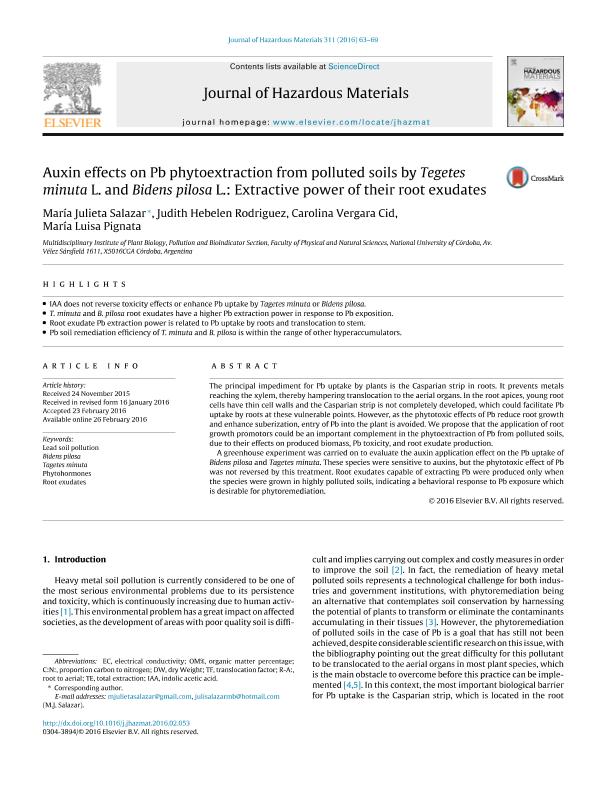Artículo
Auxin effects on Pb phytoextraction from polluted soils by Tegetes minuta L. and Bidens pilosa L.: Extractive power of their root exudates
Fecha de publicación:
07/2016
Editorial:
Elsevier Science
Revista:
Journal of Hazardous Materials
ISSN:
0304-3894
Idioma:
Inglés
Tipo de recurso:
Artículo publicado
Clasificación temática:
Resumen
The principal impediment for Pb uptake by plants is the Casparian strip in roots. It prevents metals reaching the xylem, thereby hampering translocation to the aerial organs. In the root apices, young root cells have thin cell walls and the Casparian strip is not completely developed, which could facilitate Pb uptake by roots at these vulnerable points. However, as the phytotoxic effects of Pb reduce root growth and enhance suberization, entry of Pb into the plant is avoided. We propose that the application of root growth promotors could be an important complement in the phytoextraction of Pb from polluted soils, due to their effects on produced biomass, Pb toxicity, and root exudate production.
A greenhouse experiment was carried on to evaluate the auxin application effect on the Pb uptake of Bidens pilosa and Tagetes minuta. These species were sensitive to auxins, but the phytotoxic effect of Pb was not reversed by this treatment. Root exudates capable of extracting Pb were produced only when the species were grown in highly polluted soils, indicating a behavioral response to Pb exposure which is desirable for phytoremediation.
Palabras clave:
Lead Soil Pollution
,
Bidens Pilosa
,
Tagetes Munita
,
Phytohormones
,
Root Exudates
Archivos asociados
Licencia
Identificadores
Colecciones
Articulos(IMBIV)
Articulos de INST.MULTIDISCIPL.DE BIOLOGIA VEGETAL (P)
Articulos de INST.MULTIDISCIPL.DE BIOLOGIA VEGETAL (P)
Citación
Salazar, María Julieta; Rodriguez, Judith Hebelen; Vergara Cid, Carolina; Pignata, Maria Luisa; Auxin effects on Pb phytoextraction from polluted soils by Tegetes minuta L. and Bidens pilosa L.: Extractive power of their root exudates; Elsevier Science; Journal of Hazardous Materials; 311; 7-2016; 63-69
Compartir
Altmétricas




